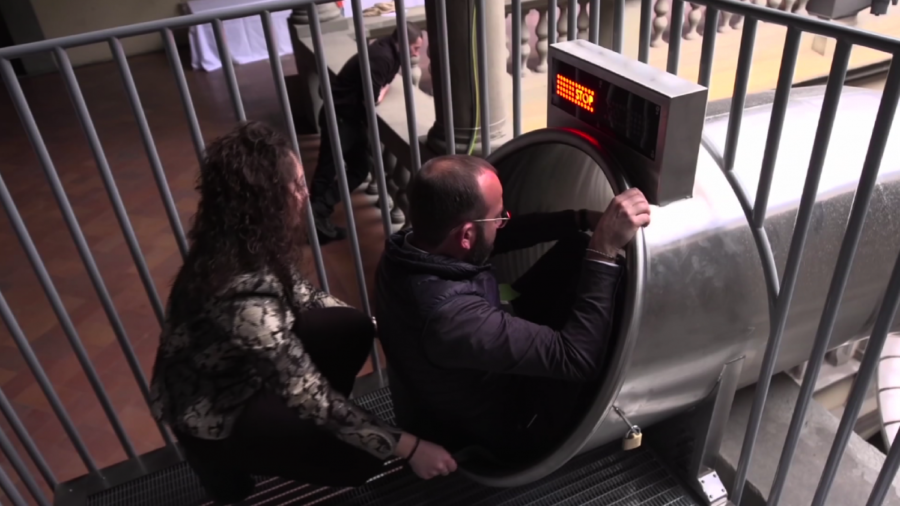
In the courtyard of Palazzo Strozzi, in the heart of Florence, two intertwined slides, 20-meters (65 feet) high, take tourists and visitors whizzing from the top of the building to the bottom.
While this historical palace, dating back to the 15th century, has housed a lot of exhibitions, this project is unique.
The slides are part of a project called “The Florence Experiment,” resulting from the work of the German artist Carsten Höller and Stefano Mancuso, professor of Plant Physiology at the University of Florence.
The main purpose is to investigate how plants respond to the visitors’ experience.
People have to wear a belt with a bean plant in it while they go down the slide. An assistant helps them, giving them a mat to sit on as they go down.
When they arrive at the bottom of the slide, they hand the plant over to a researcher, who analyzes it.
A laboratory has been set up in the “Strozzina,” the basement of Palazzo Strozzi: The slide ride ends here. Visitors hand the plant over to a researcher and fill out a questionnaire, explaining how they felt during the way down (for example, whether they enjoyed it and whether they were afraid).
A scientist then puts a label on the plant, containing information such as the age and the gender of the person who carried it and the emotions they felt.
THE FLORENCE EXPERIMENT a Palazzo Strozzi https://t.co/NE7JUHxSnL pic.twitter.com/GHGq0E59rS
— ANDREA PAOLETTI (@ANDYFI03) April 19, 2018
Prof. Stefano Mancuso, the founder of the science of Plant Neurobiology, explains how the researchers determine the response of the plants.
“Visitors, who participate in this experiment, take the plant, they carry it down to the Strozzina laboratory, where researchers analyse first of all the photosynthesis – which is the engine, the heartbeat of plants—and then they analyze the VOCs (Volatile organic compounds), that are messages sent by the plants.”
Researchers use an instrument, called Licor 6800, to analyze different photosynthetic parameters from the leaves and the gas exchanged to measure the plants’ response to the experience.
There is also another experiment taking place in the basement of Palazzo Strozzi: here two cinemas have been set up and scientists will try to find out if visitors’ emotions influence the growth of plants on the building façade, as Mancuso explained.
“The second part (of the experiment) concerns two cinemas also situated in the Strozzina, the former basement of Palazzo Strozzi. One of these cinemas is called ‘Cinema of Happiness,’ the other ‘Cinema of Fear’ because very different movies are screened in each: in one comedies and in the other horror movies, and the air, the atmosphere created by the visitors who are watching these movies, is taken and sent through pipes to the façade of Palazzo Strozzi, where they should influence the growth of the wisterias.”
The Florence Experiment has a double purpose: Mancuso said that while the first goal is to measure the effect of human beings and their emotions on plants, the artistic one is to raise people’s awareness on how much we depend on plants.
Take it from the top! Today I became part of #TheFlorenceExperiment at @palazzostrozzi. "I climbed up the temporary stairs to the height of the third floor balustrade, settled into the giant tube with a cloth underneath me, and hurdled myself down 20 met… https://t.co/d44fgyybYW pic.twitter.com/bySRqC72gz
— Alexandra M. Korey (@arttrav) April 17, 2018
“The Florence Experiment is basically two experiments that we do in order to look at the possibility of plants can respond to human emotions. And I don’t think that that has ever been done before, at least not on this scale and with this kind of an experiment so it’s both, you know, scientifically correct and artistically challenging and I want these two units to be there present next to each other,” Carsten Höller said.
One of Höller’s most famous works is “The Double Club,” a bar and restaurant in London opened in 2008 and closed in 2009, which created a dialogue between Congolese and Western culture. Before being an artist, Höller was a scientist, trained in Phytopathology (the study of plant disease).
“Many of my works are, what I call, Double Clubs, because we also have been doing night clubs and other works that are composed out of two or more different entities that are present at the same time in the same space but they are not necessarily making one; there’s no fusion really and the same it’s also too here in some way, there’s a scientific part and there’s an artistic part but there’s not that the two form one unity, they’re standing next to each other with the same amount of, how can I say, presence,” Höller said.
The newest experiment is not the first time in history that art and science have gone hand in hand. Arturo Galansino, General Director of the “Palazzo Strozzi Foundation” (“Fondazione Palazzo Strozzi” in Italian), explains that this combination was very common in the past, especially in Florence during the Renaissance.
“The ‘Florence Experiment’ is an exhibition-experiment which aims at reinforcing a traditional Florentine duo, composed of art and science,” said Galansino. “Art and science have been traveling together for a long time, let’s just think about Florence in the 15th century, (people such as) Filippo Brunelleschi, Leon Battista Alberti and above all Leonardo Da Vinci, and how art and science were inseparable.”
Around 100 people per hour can descend the slide, made of steel and polycarbonate. The average speed is 5 meters (16 feet) per second, but in some cases, it can even reach 7 meters (23 feet) per second.
At this stage, the researchers are gathering information. The results are expected to be made public after the experiment comes to an end on Aug. 26.
Recommended Video:

